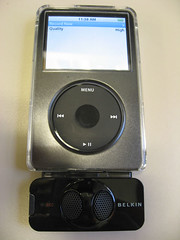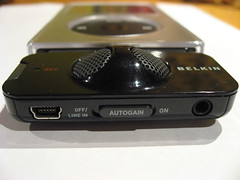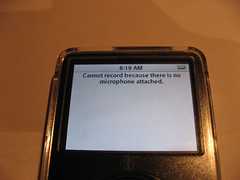Apple iPod recorder + Belkin TuneTalk Stereo review

image by sridgway
An interesting feature of the 5G iPod video and the new second generation iPod 2G Nano's is their capacity to record 44/22 Khz 16 bit audio. The trap is that you have to buy a third party attachment to realise this potential.
I recently purchased a Belkin TuneTalk Stereo to test with a 30 gig iPod video. The Belkin Tune Talk Stereo is a audio recording attachment designed specifically for the 5G iPod video. The unit is made by Belkin and sells for around $90, and are currently available in Australia.
As a podcaster I was interested in being able to use the iPod as an audio recorder. Many of our teachers and students have Apple iPods and this represents an effective way to provide them with the capacity to record audio for podcasting or digital story telling.
Features
- Internal omnidirectional stereo microphone
- Can be used with most Ipod cases
- External microphone input (3.5mm stereo), "Plug in Power" compatible
- Line in via external mic jack
- Real time adjustable gain for varying input levels
- Clipping indicator led
- Charge while recording with included cable

image by sridgway
Click on the image above to see a larger flickr pic with notes
It plugs straight into the connector on the bottom of the iPod even with a cover attached. It's a very snug fit and feels a very solid and secure connection. Wether the iPod is switched off or on, once connected it will jump to a menu ready to begin recording. On the top is the internal stereo microphone. Along the bottom from left to right are a cable connector which when used with the supplied cable, provides full functionality with itunes and usb power, an AutoGain switch and an 3.5mm external microphone/Line in jack.
The auto gain switch has 2 settings
ON – In this mode the automatic gain control is operational for either the internal or external microphone. This is the only mode the internal and external mics will work as the other mode sets the input to line levels which renders the input sensitivity too low for the signals from the mics.
The auto gain works by monitoring the signal level and increasing the amplification when the signal gets low, acting to even out the overall signal. This is great if you have speakers situated at varying distances from the microphone. However Auto gain is a problem when you have background noise as this will be amplified.
My experience has been that the audio quality recorded using either the internal or external microphone have been superb.
Sample Audio file recorded with internal Microphone
http://ssielearning.tafensw.edu.au/audio/acal06_20061007_michael_coghlan.mp3
Sample Audio File using Visivox external microphone
http://ssielearning.tafensw.edu.au/audio/talkingvte_20061205_stephan_ridgway.mp3

image by sridgway
OFF/Line in – In this mode the automatic gain is turned off and the input sensitivity of the external microphone socket is reduced to line levels. This is used when you are recording from a device with line level output ie mixing deck, computer output, cd player etc. I have connected this to mixing decks at conferences with great results. I often record interviews using a visivox microphone and preamplifier which outputs at line levels. Once again, the recordings using line in mode have been superb.
Sample Audio File using Visivox external microphone and preamp
http://ssielearning.tafensw.edu.au/audio/rtf_forum3_20061128_vox_pops_stands.mp3
Battery life
One of the draw backs using the 5G iPod video with the Belkin is the limited battery life. Because the ipod records in uncompressed format the data rate is large, resulting in the hard drive being continually in operation. My experience with recording using the sample rate of 44 Khz is little more than one hour. On their website Belkin provides the following guide to recording times with 5G ipod video.
Battery life estimates:
30GB High Quality: 1 hour, 50 minutes
30GB Low Quality: 2 hours, 55 minutes
60GB High Quality: 2 hours, 55 minutes
60GB Low Quality: 4 hours, 30 minutes
Approximate Total Recording Capacities when used with external power supply via the TuneTalk USB port:
High Quality: 94min/GB, 43 hours on a 30GB iPod, 86 hours on a 60GB iPod
Low Quality: 378min/GB, 175 hours on a 30GB iPod, 350 hours on a 60GB iPod
http://www.belkin.com/support/kb/kb.asp?a=3905&langid=
I frequently record conferences where I need to connect to a mixing deck and leave it record for hours at a time. For this application, I continue to use my trusty Iriver mp3 encoder. If you are recording interviews which last for 10 min or so, the ipod video is ideal. This is offcourse a limitation of the ipod itself rather than the Blekin and can be overcome by using one of the new 2G ipod Nano’s which use flash memory and have longer battery life. (see a future review)

image by sridgway
One problem I did encounter was that if I plugged the unit into the ipod video while turned off it would navigate directly to the voice record menu and fail to record, returning the error message shown above "Cannot record because no microphone attached"
Did some searching of the apple support forums and found I was not alone in encountering this bug. Turns out, if you turn the ipod on prior to connecting the Tune Talk it all works fine.
Conclusion
Overall the Belkin TuneTalk Stereo is a great tool to enable audio recording on your 5G ipod or 2G Nano. It has numerous features such as the external power lead & auto gain which set it apart from it’s competitors on the market. Would be great if it encoded directly to mp3 and had some input level adjustment; however the quality of the recordings I have made have been superb.
Technorati Tags: podcasting ipod tlnw tunetalk nswlearnscope07 clcommunity
Labels: podcasting mp3recorders

1 Comments:
Hi Stephan,
The recording with TAFE Library staff was forwarded to me by Leigh Blackall of the Otago Polytechnic. I work in the library and he knows I am new to all the Web 2.0 technology and wanted my comments. He thought you may like them too! So here goes...
The conversation made very interesting listening. I'm pretty chuffed that I understood most of what you were explaining. If I'd listened to the recording knowing nothing about web 2.0 it would be gobbledy gook. As the talk progressed, I realised that I've come to absorb what it means, not by someone explaining it to me, but by doing it. Half the time I've had no idea what people were talking about, especially if it's techno geek stuff, but actually doing it makes sense out of it.
Some issues that concerned me about the usage of Wikipedia and it's content were discussed, and it's good to see other people have the same concerns as myself. This made good listening.
The other thing I became aware of during the recording is that I have begun to think differently about sharing, responsibility, planning and learning. I'm not sure at what point this started, but it has.
Although I still have some uneasiness about SL, I can see it has fantastic possibilities for the library, and I'd like to see the possibilities discussed in my workplace.
In my very humble opinion Web 2.0 has all kinds of potential for teaching and learning, epecially if it is used and combined with traditional teaching methods. It has the potential to provide staff and students with greater access to information and for them to participate in a way that could not have happpened before.
I can see lots of ways the library can use the new technology and make itself more accessible and fun to use, both in a physical and virtual sense. We live in exciting times.
Wendy Ritson-Jones
Library Assistant
By Wendy, at 1/3/07 07:52
Wendy, at 1/3/07 07:52
Post a Comment
<< Home